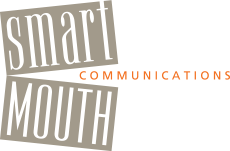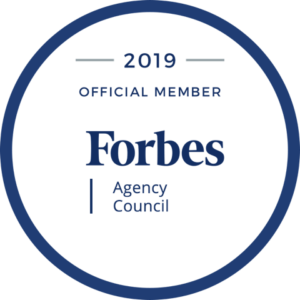SmartMouth Talks!
Digging Deep
 It’s so funny that when someone achieves an admirable position or level of success, we use the phrase, “they’ve arrived.” The word “arrived” usually implies the end of a journey, but it’s often just the beginning of a new one.
It’s so funny that when someone achieves an admirable position or level of success, we use the phrase, “they’ve arrived.” The word “arrived” usually implies the end of a journey, but it’s often just the beginning of a new one.People who rise to the top and assume leadership positions also assume an increasing – sometimes consuming – level of communication responsibilities. They find themselves needing to transition from their comfort zone of doing and overseeing, which they’ve done really well, to talking … talking A LOT. They talk to educate, sell, inform, motivate, persuade, reassure, and influence.
To be effective – and, even more pressing these days, to be authentic – leaders who want to succeed as much at talking as they did at doing and overseeing would be well-advised to take a good, hard look down deep inside themselves and inventory what they’ve got – personal stories (or not), compelling messages (or not), front-of-the-room charisma (or not).
And then begins the real work, the real journey.
This is not just for leaders, everyone can benefit from digging deep, so here’s what you want to look for deep inside yourself:
What are your prime motivators? Really. Truly. What drives you? Even if it feels unrelated to the work you do, describe it, share it. Was there someone who inspired or mentored you? Was there an influencing event or situation from your childhood? If it’s real and it’s you, it’s relevant.
What are your biggest holdbacks? Flaws, even? Self-awareness is a winning connector with any audience, just as self-deprecation is the safest form of humor with any audience. But seriously, think about the blocks and hurdles you place in your own way, or think about the traits you sometimes exhibit that aren’t so flattering. Are you willing to call yourself out and share them? Can you tie them to a lesson learned? If it’s real and it’s you, it’s relevant.
What excites you about your work? What scares you? What keeps you up at night? How do you view and feel about your team? If it’s real and it’s you, it’s relevant.
What’s your why? With so many people wanting meaningful, fulfilling, purposeful work, it’s important to be able to articulate why. The why we do what we do has become the new mission, vision and values of the old days.
And finally, what’s your personal communication style? Are you comfortable at the front of the room or uncomfortable? What self-perceptions are you holding onto that no longer serve you or that are no longer accurate? Can you let go of them and can you use positive imagery to re-imagine yourself as a more engaging speaker? What aspects of your presence are you comfortable with or confident in – voice, posture, hands, body language? Can you emphasize what works for you, what you like, and then work on the rest?
No matter what level of success you achieve, the journey of being an effective, engaging, connecting, communicator will be ongoing, so to access what you need to use to be at your best, dig deep!
Nerves Again
 Nerves versus focus. Dread versus opportunity.
Nerves versus focus. Dread versus opportunity.
In a recent Harvard Business Review article on calming nerves before a presentation by Amy Jen Su of Paravis Partners, Amy cites a few tidbits of insight and advice I offered when she interviewed me for the article several weeks ago. One of my quotes surprised even me as I was saying it, as it actually highlighted a new twist on how to view and manage nerves.
Here’s the excerpt: Levine advises, “Think of a quarterback playing in his first Super Bowl game. Yes, he may be nervous, but he’s not dreading it or seeing it as an obligation. He’s seeing it as a great opportunity that he’s ready to sink his teeth into. The nerves are a signal that this is something that matters to him.”
What is not new about what I said is that a mindset shift – more to the positive side of things – can be incredibly helpful. Usually that mindset shift involves thinking positively about performing well or about the audience assuming you’ll be successful.
What is new about what I said is that the mindset shift should be more specific – from dreading a presentation or looking at it as an obligation and something you need to simply survive to looking forward to it as a challenge to be conquered and an opportunity to shine.
In other words, your nervousness is not a block or an annoyance, it’s a signal that you have a great opportunity ahead of you to show your stuff. For more insights, read the article here.
Give Voice
 At SmartMouth we talk a lot about content, in particular how to structure and present it, but once you have that down, you need start thinking about your physical presence. One of the most important aspects of your physical presence is your voice. Your voice literally sets the tone of your presentation and, if done properly, connects your audience to you. Your voice also establishes your credibility and trustworthiness.
At SmartMouth we talk a lot about content, in particular how to structure and present it, but once you have that down, you need start thinking about your physical presence. One of the most important aspects of your physical presence is your voice. Your voice literally sets the tone of your presentation and, if done properly, connects your audience to you. Your voice also establishes your credibility and trustworthiness.
Now, the problem with the physical aspects of communicating is that everyone has different mannerisms and physical characteristics, and we don’t believe in forcing everyone to fit a certain mold. What works for one person, doesn’t always work for another. However, how you use your voice is something that can be relatively easily modified and have a big impact.
There are three key tips that we give our clients to help engage the audiences with their voice:
- Modulate your voice. Avoid speaking in a monotone. Regularly adjust the tone, volume, and pitch of your voice. The audience needs change to draw their attention back to you. That can be something as simple as walking around the room or changing a slide, but your voice is one of the most effective ways to draw the audience’s attention back to you. Also, monotone suggests to the audience that you’re bored and don’t care. And why should they care if you don’t sound like you do?
- Match your voice to your words and the moment. When you are talking about something sad or happy, make sure your tone matches the emotion. You would be surprised how often people use a tone that is inappropriate for the moment. For example, people often think that delivering bad news, like job cuts, in an upbeat tone will make the news sound better. But the reality is that it makes it worse and alienates the audience. It will seem inappropriate and insincere to the audience. Your goal as a speaker should be to empathize with your audience, be as real as possible, and not confuse or potentially anger them.
- Don’t fall into a rhythm. A constant rhythm or tempo runs the risk of putting people into a trance. You will want to adjust your speed. Sometimes you will want to speak slowly and other times you will want to speak a little faster (never too fast, of course!). You will also want to use pauses so your audience can digest or mull over important points. It can be a dramatic pause too, allowing you to create suspense or emphasis. Tempo is a powerful tool to make sure the audience does not drift away from you.
A good voice is like a good story. It has highs and lows, suspense and excitement, and slow parts and fast parts. Your voice, like your body language, is a critical delivery tool, so use it to your advantage!
Your Best Currency
 Communication is the currency of success.
Communication is the currency of success. When you think about it, no one succeeds alone; every single one of us needs to communicate in order to get things done, achieve goals, and ultimately succeed. We exchange words and ideas more often than we exchange money.
Good communication skills are therefore critical to organizational effectiveness. Yet very few organizations embrace excellence in communication as a value or a performance imperative.
This is my personal crusade. Excellence in communication doesn’t just happen, it needs to be cultivated and nurtured by organizations.
While the direct ROI of excellence in communication may not be easily measurable, it would be hard to argue that strong communication skills don’t yield better results whether used in selling, negotiating, client and customer service, employee relations, you name it.
Both anecdotally and through research, I have become almost painfully aware that there are three elements that make a pretty compelling case for looking more closely at how communication impacts your organization.
1. Performance Issue. Over the past couple of years, I have heard from clients that communication skills consistently emerge as the #1 area of need in performance reviews. In fact, it’s become pretty standard for me, that whenever I meet an HR person, I now ask what tops their list of performance needs, and communications skills are always at or near the top.
2. Career Maker/Breaker. I’ve also observed that communication skills are seen as something that can make or break careers – even by organizations that don’t explicitly embrace good communication skills as a performance imperative.
Anecdotally, I’ve often been hired to coach high-level executives who are either long-winded, short-tempered or not inspiring enough. These are people in the C-Suite who might be flailing a little bit or need a boost; they may be technically competent but communication-challenged. Or I’ve worked with executives who have C-Suite potential but their ability to communicate clearly and influence with confidence is just not there yet.
There’s also research that shows how recruiters and employers view and value communication skills, which impacts people’s careers:
According to a 2014 survey of 565 global employers by the Graduate Management Admission Council (GMAC), which administers the business school entrance test, corporate recruiters ranked communication skills ahead of teamwork, technical knowledge and leadership when assessing MBA graduates for mid-level jobs. They rated communication skills ahead of managerial ability by a two-to-one margin.
Also in 2014, in an online survey of 845 North American business executives, respondents identified leadership and effective communication as the two most important management competencies – as well as the two most in need of improvement!
3. Complaint. We can’t close the case for putting communication skills on the corporate values list until we look at one of the biggest complaints in the business world – and one of the biggest impacts on organizational effectiveness – which is long, boring, tedious meetings and presentations.
It is estimated that there are 25 million meetings in the U.S. per day, 30 million PowerPoint presentations per day, and that more than $37 billion per year is spent on unproductive meetings. Yikes!
C-Suite executives are estimated to spend 85% of their time with other people – largely in meetings. Upper management spends 50% of their time in meetings. And middle management spends 35% of their time in meetings.
Why do I pick on meetings and presentations? Because they are the most common and most pure vehicles for business communication. They’re supposed to be productive, but we know otherwise.
Communicating is not something people just do. When performance and success are on the line, it needs to be thoughtful and deliberate.
You all do a lot of communicating, so embrace it and get it right. Your organization’s effectiveness and success depend on it!
The Foolproof Five
 More often than not, what makes people freeze before a big presentation is the nagging question, “Am I even doing this right?” and its companion, the fear of embarrassment.
More often than not, what makes people freeze before a big presentation is the nagging question, “Am I even doing this right?” and its companion, the fear of embarrassment.I’m always taken aback when smart, successful, otherwise confident people reveal that they’re afraid to make a fool of themselves. I would never have guessed in most cases.
Trust me when I say that no one is “a natural” at speaking and presenting; even the best of the best think about it, worry, and work at it. Regardless of your style or your comfort level with public speaking, it’s wise to consider some core guiding principles for yourself as a speaker.
Below are five foolproof principles of being an effective speaker or presenter that will give you the confidence to know you’re “doing it right,” and will leave your audience quite impressed.
The five principles are:
- Audience-centricity
- Transparency
- Graciousness
- Brevity
- Preparedness
- That you care about and respect them.
- That you’re real and therefore credible and trustworthy.
It may be a new term to you, yet it’s probably the most fundamental of the five principles. Simply put, audience-centricity is making the audience’s interests and experience a top priority in the planning and execution of a talk.
Too many speakers prepare and deliver what is important and interesting to themselves without enough careful considerations of their listeners. Being audience-centric is a mindset shift that encourages the speaker to prepare and deliver content in a way that will matter to and resonate with the audience.
Transparency
It is exactly what you think it is; it’s about being open and direct — yes, and honest, too. Transparency is critical. It contributes to the levels of sincerity and trust that are accorded to you by your audience.
Graciousness
It is the art, skill, and willingness to be kind-hearted, fair and polite. As motivators and influencers, love and peace work far better than anger and war. Speaking in positives rather than negatives leaves lasting, favorable impressions.
Brevity
Brevity is a crowd-pleaser and needs no further introduction.
Preparedness
Preparedness speaks for itself as well. The unprepared speaker is the one who is most likely to be long-winded, not to mention unfocused. While the mere thought of preparation might bring feelings of dread, the feeling of approaching the front of the room ill-prepared is far worse – and it shows.
Success is in the eye of the beholder – your audience. Show care and respect, be real, and your audience is much more likely to listen, like you, and be impressed.
[Excerpted in part from Jock Talk: 5 Communication Principles for Leaders as Exemplified by Legends of the Sports World, www.jocktalkbook.com]
WIIFM
 WIIFM. What’s in it for me? This is the universal question every audience member is asking themselves when they’re attending a meeting, sitting through a presentation, or listening to a speech.
WIIFM. What’s in it for me? This is the universal question every audience member is asking themselves when they’re attending a meeting, sitting through a presentation, or listening to a speech.
WIIFM has become a popular acronym in business. It’s a reminder to business people that whatever it is they’re talking about – or let’s face it, sometimes huckstering! – they need to consider the unique needs and interests of their audience and direct their remarks so they convey the potential benefits to their audience, especially if those benefits may not be obvious.
You know from your own firsthand experience as an audience member that WIIFM runs through your own head plenty of times, that you want something in return for your time and attention, and that you feel more satisfied, more impressed (with the speaker), more “heard” and valued when you get something out of a talk.
Conscious or subconscious, people are waiting to have their self-interests met. Sometimes the “me” is more like an “us” – a collective me, as in “okay, what’ve you got to give us?” – because the group has a common self-interest. Regardless of whether it’s individual or collective, the bottom line is this: You, the speaker have a topic and an objective. The audience has a self-interest. Your work is to bring those two factors into alignment. If you can do this, it will always, always, always serve you well.
So, if you’re the speaker, here are 3 simple ways to think about addressing your audience’s WIIFM:
New. Given your topic, is there a new angle or twist? An update or a surprising bit of news? Do you have something that other people don’t know yet? Something this audience hasn’t heard or considered yet?
Useful. Given your topic, is there an application this audience could use? Can you help them sort through or think through a common problem in some way? Do you have a solution to something they face?
Beneficial. Given your topic – and, more importantly, given what keeps your audience up at night – what is it that you have that will help them? What is it about your topic that will benefit your audience? Is there a silver lining for them? A net gain?
The companion acronym to WIIFM, in SmartMouth vernacular, is IAAT – It’s all about them! No matter what, your audience’s needs and interests and experience reign supreme. Think through what you have that’s new or useful or beneficial to them, and plan accordingly for your next turn at the front of the room!
Jocks Talking in Rio
 The Olympic Games are upon us and not only is the USA winning in the medals race, but many of our athletes are setting some great communications examples. Naturally, there are so many terrific examples coming out of Rio right now and, while most of them are stellar and memorable in their own ways, some are not Olympic quality. Let’s take a look at one winning and one losing example in today’s post.
The Olympic Games are upon us and not only is the USA winning in the medals race, but many of our athletes are setting some great communications examples. Naturally, there are so many terrific examples coming out of Rio right now and, while most of them are stellar and memorable in their own ways, some are not Olympic quality. Let’s take a look at one winning and one losing example in today’s post.
In the winner’s circle: I found Kayla Harrison’s post-win interview with NBC particularly noteworthy. Kayla won gold for the US in Judo (78KG division) for the second time in a row and thus making her the most decorated American Judoka of all time and of any gender.
When Liam McHugh of NBC asked her about her experience of being booed by the crowd in Brazil, Kayla embraced the Jock Talk principle of #graciousness. She could have taken the low road and been critical of the Brazilian crowd, but instead she turned it around. She took the high road and turned a negative into a positive. She said she actually enjoyed being booed, because it made her feel like “the bad girl,” which was something she found refreshing and different.
This should be no surprise coming from Kayla as taking the high road, being positive and helping others is her brand. Kayla is someone who suffered sexual abuse at the hands of a coach when she was in her teens, but has overcome that to become a history-making world-class champion. Additionally, she is using her star power to found a non-profit to help victims of abuse. Kayla does not back down from tough questions or the hard truth, and she manages to find the positive even in bad situations.
Not every American athlete, however, has followed Kayla’s lead.
In the loser’s circle: After getting knocked out of Olympic soccer tournament medal-less by Sweden, USA’s Hope Solo kept up her streak of controversial comments by calling the Swedish team “a bunch of cowards.” (Whoa! Was that really necessary, Hope?) This kind of negative language immediately makes her into the bad guy and the Swedes into the good guys. No one likes a sore loser, especially at the Olympic Games. Even if she had had a legitimate point, that point would have been lost to the uproar over the negativity of her reaction. (Sportsmanship, Hope!) A lack of #audience-centricity and #graciousness with a little too much #transparency predictably leaves a bad taste in people’s mouths.
When the world comes together in the spirit of peace and athletic competition, there’s no room for anything but #audience-centricity and #graciousness. And really, this provides a good lesson and model for the rest of us – even if we’re not Olympians – which is to embrace #audience-centricity and #graciousness no matter what, at all times. It’s a winning combo!
Do I Sound Smart?
 During our recent webinar, “Getting Your Point Across,” we polled participants to find out what they were most concerned or fearful about when giving a presentation. We asked the question two different ways and both sets of answers yielded the same result. By far, the most pervasive concern of the participants was that they might appear or sound “stupid.” I found this so interesting!
During our recent webinar, “Getting Your Point Across,” we polled participants to find out what they were most concerned or fearful about when giving a presentation. We asked the question two different ways and both sets of answers yielded the same result. By far, the most pervasive concern of the participants was that they might appear or sound “stupid.” I found this so interesting!
So interesting for two reasons:
- The reality is that most audience members don’t go into a presentation preparing to judge whether or not a speaker is smart. They go in hoping to get something good or new or useful out of it. In fact, if anything, audience members assume that the person at the front of the room is intelligent.
- Worrying about whether you’ll sound stupid, while understandable, is a misplaced concern for a speaker. Worrying about connecting with and engaging the audience is a far more worthwhile concern. If you don’t connect and engage, it won’t matter how intelligent you sound.
If this concern resonates with you – and you are inclined to feel the way our webinar attendees did – here are some quick fixes to help you connect and engage:
- First, get to know as much about your audience as you can beforehand. That way, you will have some “entry ramps” to use in order to build connection.
- Prepare some relevant questions ahead of time – thoughtful, thought-provoking questions that might help engage your audience, build suspense, or get a dialogue going (if the group is a manageable size). One small caveat is that you’ll need to have answers to these questions at the ready in case your audience goes radio silent on you.
- Keep your points succinct and limit the amount of detail you share. Plan your time so that you can open it up for a quick Q&A after each major point or section of your talk. That way, if your audience wants more detail, they’ll ask for it, but you won’t have killed them with TMI unnecessarily!
- Tell stories. Be self-deprecating. Be open and vulnerable. And always, always be relevant – to your audience and to your topic.
- Prepare ahead so that you are familiar enough with your material that you can forget about your notes – and focus on your audience – once you start talking. (Winging it is one of the best ways to appear or sound stupid. Don’t take that risk.)
- And finally, look at your audience. Really look at them. Yes, I’m talking about eye contact. But I’m also talking about how you look at them – look at them as potential friends you want to make, not as adversaries or a firing squad. Your attitude and energy will rub off on your audience, so keep it positive!
All of this is to say, focus on your audience and the experience you want to give them rather than on how you sound. You’ll survive the event either way, so put your attention on them!
Horse Sense
 This unusual take on overcoming nervousness comes straight from the horse’s mouth, original public speaking guru Dale Carnegie:
This unusual take on overcoming nervousness comes straight from the horse’s mouth, original public speaking guru Dale Carnegie:
Students of public speaking continually ask, “How can I overcome self-consciousness and the fear that paralyzes me before an audience?”
Did you ever notice in looking from a train window that some horses feed near the track and never even pause to look up at the thundering cars, while just ahead at the next railroad crossing a farmer’s wife will be nervously trying to quiet her scared horse as the train goes by?
How would you cure a horse that is afraid of cars—graze him in a back-woods lot where he would never see steam-engines or automobiles, or drive or pasture him where he would frequently see the machines?
Apply horse-sense to ridding yourself of self-consciousness and fear: face an audience as frequently as you can, and you will soon stop shying. You can never attain freedom from stage-fright by reading a treatise. A book may give you excellent suggestions on how best to conduct yourself in the water, but sooner or later you must get wet, perhaps even struggle and be “half scared to death.” There are a great many “wetless” bathing suits worn at the seashore, but no one ever learns to swim in them. To plunge is the only way.
― Dale Carnegie, The Art of Public Speaking
Eloquence
 Recently I listened to NPR’s Doug Fabrizio of “Radio West” as he interviewed British linguist David Crystal about his new book, “The Gift of the Gab: How Eloquence Works.” It was a fascinating and validating piece on what it takes and means to be a persuasive and impactful speaker. He and I agree on many important points.
Recently I listened to NPR’s Doug Fabrizio of “Radio West” as he interviewed British linguist David Crystal about his new book, “The Gift of the Gab: How Eloquence Works.” It was a fascinating and validating piece on what it takes and means to be a persuasive and impactful speaker. He and I agree on many important points.
For starters, Crystal has an interesting theory that really everyone is eloquent. And I would have to agree there is a lot of truth to this. All of us have had impassioned personal conversations and convincing one-to-one conversations. However, we often assume this is not a skill transferable to the podium and to a larger audience. The larger an audience gets, the more nerve-wracking it feels to the speaker, but the reality is that the fundamental skills you use to be eloquent or persuasive when speaking one-to-one are the same for a larger audience.
Crystal notes that preparation and rehearsal are keys to eloquence. Very few people can step up on a stage unprepared and then be eloquent. Preparation not only helps you be more fluent, but it also boosts your confidence. Yet a lot of speakers are so full of dread that they avoid preparation (denial!) and then at the last minute wing it. In the end, though, this makes everything worse. It affects the speaker’s ability to genuinely project confidence as well as the ability to be truly connected to the audience – as the speaker will be more focused on trying to remember what he or she was supposed to say next. The only cautionary warning about preparation is that there is a fine line between being prepared and being over-prepared. Audiences recognize and dislike speakers who feel forced or fake. You have to prepare just enough to be fluent with your material and be natural.
Another good point that David Crystal brings up, and one that I always tell my clients, is that the most annoying thing for an audience is when a speaker does not keep to time. That is an instant speech killer. If you are scheduled to talk for 20 minutes, talk for 20 minutes, not 30 minutes and not even for 22. The longer your speech is, even if the time expectations have been set for the audience, the greater the chance you have of losing your audience. With long speeches or presentations, you have to build in moments that bring the attention of your audience back and make sure to add pauses and little breaks so the audience has time to process what you are saying. But no matter what, to go over your allotted time is just about the most audience-unfriendly thing you can do.
In the same vein, it is very easy to overload an audience even in a short speech or presentation. Often, speakers become excited about their material and offer too much or speak too quickly and thus the audience does not have time to understand or comprehend what they are saying. Even in the best of speeches, the audience won’t remember everything, but as David Crystal says, “in a good speech you remember fragments, in a bad speech you remember nothing.”
David Crystal must have been reading my mind, because we agree on another important fact: people can comprehend three points, but after that comprehension takes a nosedive. It is usually best to divide a speech into no more than three important points or messages if you want to be impactful. Otherwise, if you decide you cannot pare it down to, let’s say, less than six points, you are likely to end up with an audience that remembers nothing.



